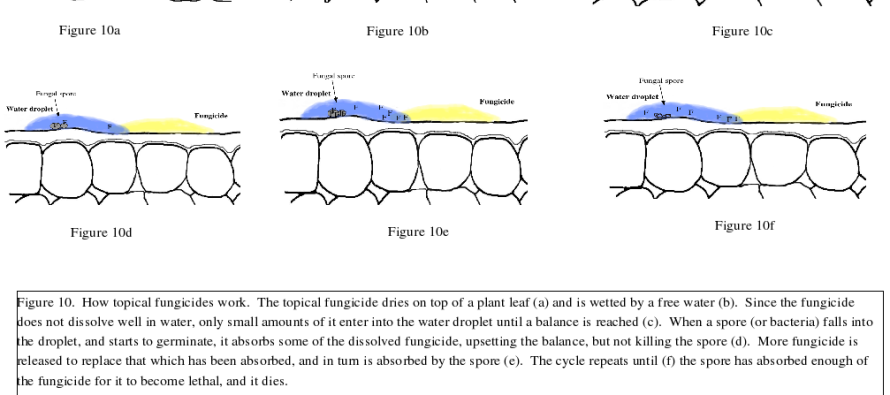Early Leaf Spot of Peanut found in the Greater Columbus Area

This last week I found early leaf spot in the Greater Columbus, Mississippi area. For information and images on how to identify early leaf spot, please see: https://www.mississippi-crops.com/2013/08/12/early-leaf-spot-of-peanut/ and https://www.mississippi-crops.com/2012/09/05/early-leaf-spot-found-in-the-greater-aberdeen-area/
Early and late leaf spot are major defoliators of peanuts and can be responsible for significant yield losses. In fact, these two diseases are the reason for the traditional two week spray schedule in established production areas (Figure 1). Even if the leaf spots are controlled, the two leaf spots are responsible for about 10 fungicide sprays and many associated expenses in established peanut growing areas.
Figure 1. Traditional peanut spray schedule in established peanut growing areas. Note that all of them target “leaf spot”, meaning early and late leaf spot.
The two leaf spots are such problems because they over winter in the previous years peanut debris and infect the new years crop. This means that they are starting to become a problem as early as day 40. Overwintering is probably what happened in south Mississippi and the Columbus area this year.
The least expensive management for the two major leaf spots is crop rotation. Please DO NOT PLANT PEANUTS AFTER PEANUTS. Please rotate (> 3 years to other crops). You will put money in your and your neighbors pockets! The lack of these leaf spots in our production area has been a major reason for our profitability up to this time. Please do not hurt everyone by shortening your rotations.
FUNGICIDES FOR LEAF SPOT MANAGEMENT
All fungicides work best as a protectant. That is, they work best if they are present before the fungus is introduced. After a fungus has infected a plant, produced a lesion and started reproduction, fungicides will seldom stop it, but may stop other fungi from entering the plant and from producing new reproductive structures.
If you are growing peanuts in an area where early leaf spot has been found, the least you should do is keep a thorough coating of chlorothalonil on your plants (see below).
If you have recently discovered early leaf spot in one of your fields, you should mix a penetrant, especially a triazole type fungicide (https://www.mississippi-crops.com/2013/02/19/2013-list-of-peanut-fungicides-labeled-in-mississippi/) with the chlorothalonil.
Chlorothaloinil
The oldest (and still one of the best) fungicides for leaf spot management is cholothalonil. This fungicide kills fungal spores, especially germinating fungal spores at least five different ways. As far as I know, there has never been an instance of a fungus gaining resistance to chlorothalonil.
Chlorothalonil acts as a raincoat on the outside of the plant. It protects the plant from the shower of fungal spores.
Like a rain coat, chlorothalonil does not grow with the owner, so the growing plant will have stems and leaves that are not protected by the “rain coatâ€, just like a rapidly growing child’s wrists and forearms will stick out from the sleeves of the rain coat and get wet.
This means that chlorothalonil will need to be reapplied frequently (ca. 14 days) to protect the plant. It also means that it needs to be applied in sufficient water and with sufficient pressure so that the entire plant is coated with small fungicide droplets (Figure 2).
Figure 2. Leaf well covered with chlorothalonil.
Figures 10a-f show why and how topical fungicides such as chlorothalonil, work.
A good coat of chlorothalonil (about 1 to 1.5 pints/A) provides inexpensive but vital protection against the peanut leaf spots. There are at least seven brands of chlorothalonil labeled for use in Mississippi peanuts (https://www.mississippi-crops.com/2013/02/19/2013-list-of-peanut-fungicides-labeled-in-mississippi/). They are Bravo, Chloronil, Chlorothalonil, Echo, Equus and Initiate.
Figure 10a-f shows both how a topical fungicide such as chlorothalonil works and why a good distribution on the surface of the plant is necessary.
The other major peanut fungicides kill leaf spots one way, but there are now three major FRAC groups which each kill in a different way. A major item in these fungicides favor is that most can penetrate into the plant and spread some inside of it. This means that good external plant coverage is not as essential as it is with chlorothalonil.
Penetrant type fungicides
The three major fungicide FRAC types labeled on peanuts are the triazoles or DMI inhibitors (FRAC group 3), the strobuliurins or Quinone outside inhibitors (FRAC group 11), and most recently the SDHI inhibitors (FRAC group 7) (Thank you BASF and DuPont for these additions to our fungicide rotation!).
The oldest of these is the active ingredient tebuconazole. Originally sold as Folicur, tebuconazole is now generic and sold under about ten different trade names (https://www.mississippi-crops.com/2013/02/19/2013-list-of-peanut-fungicides-labeled-in-mississippi/). You can buy it for about $4.00-$5.00/A. It can still be an effective product if not placed under a lot of leaf spot pressure. If you have conducive leaf spot weather coming (rain and warm temperatures), or you have been exposed to a lot of spores, you should probably use another product.







Let me tell You a sad story ! There are no comments yet, but You can be first one to comment this article.
Write a comment